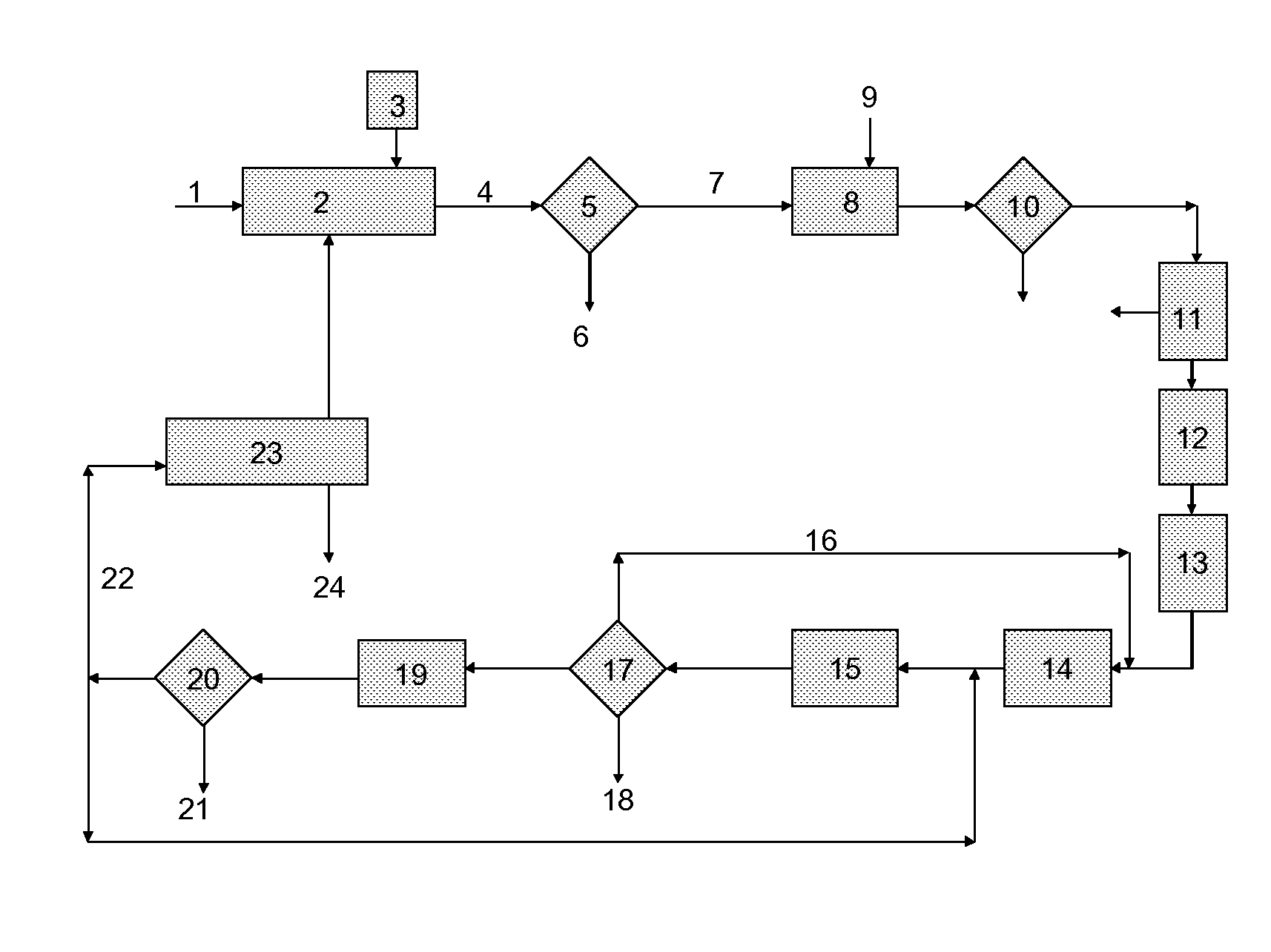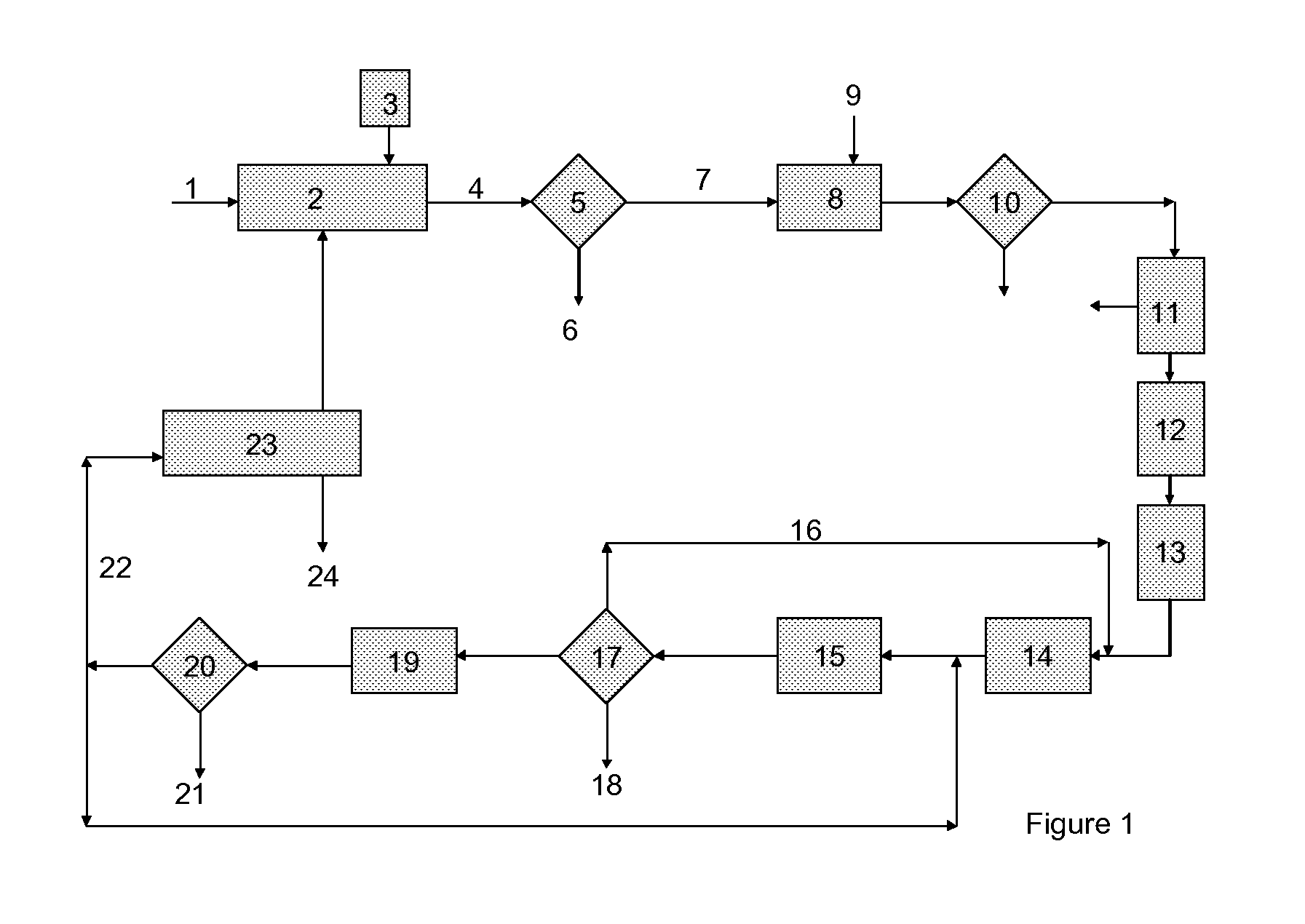Process for the combined regeneration of soluble salts contained in a residue of an industrial process
a technology of industrial process and soluble salt, which is applied in the field of combined regeneration of soluble salt contained in industrial process residues, can solve the problems of affecting the regeneration process, and affecting the regeneration effect of soluble salts,
- Summary
- Abstract
- Description
- Claims
- Application Information
AI Technical Summary
Benefits of technology
Problems solved by technology
Method used
Image
Examples
example 1
[0059]In a perfectly stirred laboratory crystallizing dish, 500 g of residues constituted of industrial ash having the composition, measured on dry residues, of Table 1, were put into suspension in 2000 g of a reactive solution, a mixed mixture of calcium chloride and sodium chloride, the composition of which appears in Table 2. The amounts used correspond approximately to the stoichiometric amounts needed to precipitate, in the form of gypsum (CaSO4.2H2O), all of the soluble sulfates contained in the ash residues.
TABLE 1Analysis of the residuesChemical speciesg / kgK+283.5Ca++1.9Mg++0.5Na+58.3Cl−95.3SO4−−347.5Insolubles178
TABLE 2Analysis of the reactive solutionChemical speciesg / kgCa++64.9Na+32.4OH−1.5Cl−95.3SO4−−0.6H2O805.2
[0060]After stirring at ambient temperature for 3 hours, the precipitation of gypsum took place and, after filtration through a Büchner-type laboratory vacuum filter, a clear aqueous production solution was collected. It then contained 3.11 g / kg of calcium that it...
examples 2 to 5
[0076]In Examples 2 to 5 a lab filtering unit was tested. 500 grams of a residue containing the elements given in Table 4 was dissolved in 586 g of water:
TABLE 4Residue composition of elementsChemical speciesg / kgK+70Ca++63Na+25.6Cl−105SO4−−21.3OH−47.8Insolubles648Not determined18.8
[0077]In Example 2, a quantity of 63 g of hydrochloric acid 2N was added to the obtained aqueous suspension, together with 55 g of NaCl and 86 g of KCl, to simulate the purge. The suspension was then subjected to a separation step in a belt filter. The production solution had the composition indicated in Table 5. The separated particles were washed until the remaining chloride was 2 g / kg.
[0078]In Example 3, it was performed as in Example 2, except that the hydrochloric acid was replaced with 74 g of a liquid originating from a column for distilling the mother liquor from the manufacture of sodium carbonate via the ammonia process (“LDS” in Table 5), having the composition given in Table 2. The amounts of N...
example 6
[0081]In Example 6, it was performed as in Example 3, except that the production solution was further treated by addition of a stoichiometric quantity of Na2CO3 in order to eliminate remaining Ca and separation of the produced CaCO3, and by addition of 50 mg / l of FeCl2, to remove CrVI. The purified solution was finally super purified through ion exchange resins Lewatit® TP 208 from Lanxess. The composition at the output of the belt filter, the separation of CaCO3 and the ion exchange resins are given in Table 6.
TABLE 5Example2345Additive—SO4HClLDSLDSLDSNaClg / kg100.695.494.187.2KClg / kg167.5157.1155.0143.6Ca(OH)2g / kg0.40.40.40.4CaCl2g / kg7.57.77.67.0CaSO4g / kg3.13.13.12.8Almg / kgAsmg / kgBmg / kg0.050.090.612.9Bamg / kg6.78.27.78.4Bimg / kgCamg / kg3831390338513566Cdmg / kgComg / kgCrmg / kg0.430.3660.380.34Cumg / kgFemg / kgLimg / kg1.82.133.49.8Mgmg / kg0.060.10.05Mnmg / kgMomg / kg0.171.3Nimg / kgPbmg / kg0.34PO4mg / kgSbmg / kgSemg / kg0.140.532Simg / kg0.230.340.320.2Snmg / kgSrmg / kg446141.760Timg / kg0.040.1Tlmg / kg1.91.872.9...
PUM
| Property | Measurement | Unit |
|---|---|---|
| density | aaaaa | aaaaa |
| temperatures | aaaaa | aaaaa |
| temperatures | aaaaa | aaaaa |
Abstract
Description
Claims
Application Information
 Login to View More
Login to View More - R&D
- Intellectual Property
- Life Sciences
- Materials
- Tech Scout
- Unparalleled Data Quality
- Higher Quality Content
- 60% Fewer Hallucinations
Browse by: Latest US Patents, China's latest patents, Technical Efficacy Thesaurus, Application Domain, Technology Topic, Popular Technical Reports.
© 2025 PatSnap. All rights reserved.Legal|Privacy policy|Modern Slavery Act Transparency Statement|Sitemap|About US| Contact US: help@patsnap.com


